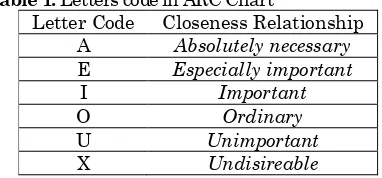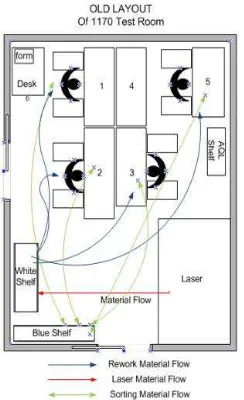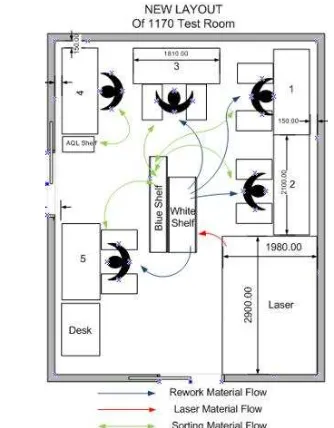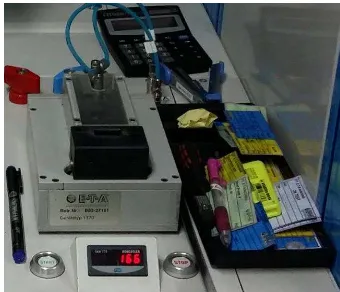Reduction Effort of
Motion Waste
in a Test Room of Component
Products
Kevin Hadisurya1, Nyoman Sutapa2
Abstract: The research’s goal is to reduce non-value-added motion or activity of a production process, which can be classified as a waste in a production process. The research is done in test room. Non-value-added motion or activity can reduce productivity and slowing production pro-cess. Improvement proposal of this research consist of re-layout proposal of test room and im-plementation of kaizen in test room. Improvement of re-layout in test room resulting in a better design of layout, showing result of reducing total travel distance of material in testing process. The new layout showing moment calculation result of 107196 meters, while the old layout’s re-sult is 153856 meters. Based on the rere-sult, the new layout implemented in test room. Kaizen im-plementation in test room is done by creating visual control, improvement implemented by creat-ing boundary line of object in test room’s workplace. Improvement also done by creatcreat-ing a place for storing any tools and equipment that support testing process, with refers to the concept of kaizen foam.
Keywords: Facility Design Layout, Moment, Kaizen, 5S, Visual Control.
Introduction
Testing process inside a testroom is consist of function sorting, which is sorting the finished product, and AQL sorting before entering packaging process. The product is one of the superiror product in the company, but there isn’t any attempt to reduce motion waste in the testroom. Some of the problem such as layout problem, working methods, standar-dization, and discipline in work are interesting aspect to be researched in reducing motion waste in test room. This research’s goal is to reduce motion waste in test room.
Methods
Facility Design Layout
Layout is one of the important aspects that exist in the industrial world. The layout of a plant (plant layout) or commonly called the facility layout can be defined as the procedures for setting factory facilities to support the smooth production process (wig-njosoebroto, 2009 [1]). The layout in an industry will organize two things, the setting of the machine (ma-chine layout) and the setting of the existing depart-ments in the industrial/plant (department layout). The layout setting at a factory or industry can be done in two things:
1,2 Faculty of Industrial Technology, Department of Industrial Engineering, Petra Christian University. Jl. Siwalankerto 121-131, Surabaya 60236. Email: [email protected], [email protected]
setting of existing layout or setting new layout. Good plant layout will provide benefit in efficiency and in some cases will also maintain the viability of an in-dustry or the success of an inin-dustry.
Sophisticated equipment as well as a good product design will be nothing without having a good layout design. An industrial production activity is always associated with a layout that does not change, so if there is any error in designing facility layout it will lead to the huge amount of loss. The main objective in designing facility design layout is basically to min-imize total cost which can occur involving element cost such as:
a. Construction and installation cost, either for bulding, machines, or other production facilities. b. Cost of moving material (material handling
costs).
c. Production cost, maintenance, safety, and work in process product inventory.
Optimal facility design layout can also provide con-venience in supervision process as well as facing the plant expansion plan in the future (Wingjosoebroto, 2009). The purpose of planning and designing facility layout can also provide several benefit such as: a. Increasing production output, good layout will
provide a greater output result with the same cost or even less.
b. Reducing waiting time.
c. Reducing material handling process, a good lay-out will reduce or minimize activity in material handling.
d. Saving the use of area for production, warehouse, and service.
f. Reducing work in process inventory. g. Shorter manufacturing process.
h. Reducing risk for health and safety of an opera-tor.
i. Improve morale and job satisfaction j. Make supervison activity easier.
k. Reducing congestion and the maze of material. l. Reducing factor that could harm and affect the
quality of raw materials or finished products.
According to Heragu (1997 [2]), the calculation of moment can be used to determine the cost of moving material ccurring in a layout. Calculation of momen is done by using the following formula:
Momen = (1)
Where:
Dij Is the distance between facility i and facility j
Fij Is the flow or movement of material between facility i and facility j.
Activity Relationship Chart
Planning the layout or planning in determining a good layout is fairly important part in designing the layout of a facility (Heragu, 1997). One of the im-portant part in planning is to know the relationship, or the relationship of each existing facilities. Know-ing the relationship of each facilities is served as the measure used to determine or qualify the interaction between departments or facilities that exist in plan-ning the layout of the facilitiy. Relations between the facility and the department can be determined by using the Activity Relationship Chart or hereinafter reffered to as ARC Chart. ARC Chart will use the codes in the form of letters that will map the level of releation between one facilities to another. Table 1 shows the letters code used in the ARC Chart.
Table 1. Letters code in ARC Chart
Letter Code Closeness Relationship
A Absolutely necessary
Letters code shows the degree of importance for as-signing a department with a specific code. A letter code is a code that has meaning between two facili-ties should be adjacent (absolutely) and weighs a value of four. E letter code has an especially im-portant closeness and weighs a value of 3. I letter code has important closeness and weighs a value of 2. O letter code has ordinary closeness and weighs a value of 1. U letter code has not important closeness,
so that between one facilities to another is not essen-tial to put adjacently or it is just ok wether those two facilities put adjacently or not. X letter code has meaning of not important closeness means other facilities should be kept away from one’s facility and weihgs rating value of -1.
Activity Relationship Diagram
Activity Relationship Chart can describe the rela-tionship between facilities using Activity Relation-ship Diagram or hereinafter referred to as ARD. Analysis of layout design with referring to the degree of closeness is one of the important thing to be con-sidered further. Activity Relationship Diagram made after the Activity Relationship Chart is done. Sym-bols and colours used in making and serving Activity Relationship Diagram can be seen in Table 2.
Table 2. Symbols and colours in Activity Relation-ship Diagram
E Especially Important Oranye
I Important Hijau
X Undesireable Coklat
Lean Manufacturing
Lean is a continuous effort to elimane waste and increasing the value added of a product, goods and/or services in order to deliver value to customers (Gasp-ersz, 2007 [3]). Lean manufacturing can identify and eliminate activities that do not give value added by doing continuous improvement. Continuous im-provement means imim-provement to the process or timeline between customer orders with delivery times by eliminating activities that do not add value (Taiichi, 1998).
over-processing, over production, and defect. In-creased productivity will be achived if it can reduce or eliminate such waste. To eliminate waste in lean manufacturing can be achieved in some ways, they are:
Kaizen
Kaizen can be defined as carrying out small im-provement activities in a sustainable manner used by many Japanese companies (Monden, 1995). Kai-zen or commonly reffered to 5S is the method used to reduce existing weakness in the plant (Monden, 1995). 5S is an abbreviation of the Japanese words, they are Seiri, Seiton, Seiso, Seiketsu, and Shitsuke which overall summarized into a cleanup acivity in the workplace.
Cleaning intended in the factory is the reduction of the goods in the processing or work in process (WIP) unnecessary products. WIP items that are not required may be leftover paint, malls, tooling, gauges are not required, used oil, trains, fixtures, tables and others that are not needed. The implementation of 5S, quality level, time of booking, and cost reduction can be repaired, this is what is referred to as the three main objectives of production management. Hiroyuki Hirano believe that by introducing 5S, a factory can supply products that customers want, in a good quality, low cost, fast, and secure so that corporate profits will increase. Five components of the 5S is defined as:
a. Seiri
Seiri in Indonesian can be interpreted as sorting objects which are not needed can be removed. Practice to apply seiri done by using the label in red rectangles so that only the necessary items that will remain in the plant. Professor Yuji Aida of Kyoto University running a sorting process called Aida method which saves an item or in-formation by not distinguishing interests but only add jobs. This makes the necessity to throw eve-rything unneeded items (Osada, 1995 [4]). b. Seiton
Seiton in Indonesian which means tidy, is the process of drafting or arrangement with a neat and marking objects to make use of objects easier. Structuring goods means storing stuff with atten-tion to efficiency, quality and safety as well as finding ways op-timal storage (Osada, 1995). Un-derstanding Seiton literally means arrange the various objects in interesting ways. Seiton in the 5S concept means arranging things so that eve-ryone can find it quickly. Sign board is used as a tool to establish the name of each item and its storage place (Monden, 1995). Stages in Seiton activity is to determine the place for items appro-priately, and then determine how to store the
goods. Rules to always keep returning goods to the same place should always be obeyed so that these activities always run continuously (Osada, 1995).
c. Seiso
Seiso in Indonesian means cleaning is an activity to always clean, maintain neatness and cleanliness. Seiso is a basic cleaning process in which a swept area then mopped with a mop. The company must be cleaned every day including the floor, the win-dows, and the walls to avoid engine damage caused by oil spills, ash, dust, or trash. Cleaning means more than just making the goods to be clean, but a commitment to be responsible for all aspects of goods used to make the goods in prime condition. Possibility of stuff jammed, disability, or an accident can be caused by dust, dirt, foreign material, the sound of a loud engine noise, therefore routine
cleaning should be done to avoid it.
d. Seiketsu
Seiketsu in Indonesian means the consolidation of which is a continuous activity to maintain seiri, Seiton, and Seiso. Stabilization means maintain-ing a clean state which includes other considera-tions such as color, shape, clothing, etc., that pro-vide a clean atmosphere (Monden, 1995 [5]). Con-solidation is also regarded as a repetition of sort-ing, structursort-ing, and cleaning as well as aware-ness and activity so that the state of 5S is still maintained. Activities in Seiketsu can usually be maintaining the workplace in order to keep it clean without waste or oil droplets (Monden, 1995).
e. Shitsuke
Shitsuke in Indonesian means habituation is a method to make workers accustomed to obey the rules that have been made. Habituation is doing the job repeatedly so naturally can do it right. 5S concept will not succeed in the absence of habitu-ation, since this is a way to change bad habits be-come better (Osada, 1995). Dr Eizaburo Nishibori (1985) says that Shitsuke is the most important thing in the implementation of 5S, therefore the people who teach new workers have to give good example. Workers must be used to place objects nearby to simplify taking of goods. Workers who have 5S knowledge alone is not enough, but should practice the many times that it becomes a habit spontaneously, of his own volition and not because of forced (Monden, 1995).
Result and Discussion
them meets the standards and regulations that exist before being packed and shipped to customers. Activ-ities that occur in the test room includes testing a trip time range of products and AQL testing before being packed. Until now there has been no im-provement efforts are being made to improve the efficiency, and the reduction of waste motion of the testroom. Several improvement efforts conducted in a testroom are described in the next section
Perbaikan Layout Ruang Uji 1170
Improvements made to the machines and other test room facilities only, while the laser machine is still part of the production segment that is not included in the repair. The layout of the test room will be mapped prior to the activity relationship chart to determine the degree of importance of the relationship between existing facilities in the test room Acivity 1170. Chart Relationship Chart can be seen in Figure 1
Figure 1.Activity relationship chart of the test room
Mapping the degree of relationship between the ex-isting facilities in the test room will be mapped to the Activity Relationship Diagram (ARD) to be able to know the better layout for test room. Mapping into ARD is expected to know the layout of the good facili-ties in accordance with the needs of each of the exist-ing facilities. ARD of the test room can be seen in Figure 2
Figure 2 shows that there are still some facilities that have a relationship that is quite important, but located far apart. Improvement proposal of facility layout will use the degree of relationship between the facilities as a reference in designing the layout of proposal improvement in the test room. Improve-ment proposal of the layout of the test room also ad-just the existing limitations they are the location of the electrical terminal for a particular machine that does not have a cable long enough to reach the elec-trical terminal.
Figure 2.Activity relationship diagram of the test room
The layout in test room feel cramped in some places and not efficient material flow streams. Some ma-chines that exist in the test room is located at the very end, but require the goods on the shelves are located on the side of the other end of the room. Long distances and must pass through a narrow area con-sidered to be ineffective for the smooth flow of mate-rial. Material flow that occurs in the test room will be displayed in the test plan space before and after im-provement.
Figure 3. Layout of test room before improvement
between the flow from the laser towards white shelves and shelves of the testing machine towards the blue, while access to the engine 3.4 and 5 must pass through a narrow area to reach the shelves of white and blue.
Ineffective material flow as well as the placement machine and a rack far enough is a problem that occurs in this test room. There has been no attempt to improve the layout from the test room until today. Layout problem contained in the test room can be overcome by changing the existing layout now in order to be more efficient and effective in performing a series of testing process. Proposed improvements to the layout of the test room can be seen in Figure 4.
.
Gambar 4. Layout of test room after improvement
Improvement proposal layout from the test room has the goal of efficiency of material flow, the material displacement distance is shorter or closer. Structur-ing the location of facilities that surround the rack allows the operator to be able to more easily reach the shelf where the material to be used, so that the material flow is more efficient. Material flow crossing each other or cut (cross-movement) do not happen again, because the rack is placed in the middle of the room and the whole machine surrounds the rack. The new layout in the test room is based on the rela-tion between the machine with the rack, which is closer to the machine that has a specific task with a shelf that contains the material to be working on
Machine 1 and 2 is a machine that has a major task to sort so that brought closer to the white shelves which is where the material that has not been test-ed. Machine 3 and 5 is the the machine that has the task to work on the product rework, so that brought closer to the blue shelves which is a rework material
is placed. Machine 4 is a machine that has a duty to AQL testing, so that shelves to wait for incoming AQL products placed next to the machine.
New layout proposal of test room will be proven technically whether it is better from the previous layout or not, by performing the calculation of mo-ment. Calculation of moments performed both on the test room before the improvement and after the im-provement, to determine whether the improvements made a positive impact or not.
Gambar 5. Perhitungan momen pada layout awal
Figure 5 is the moment calculation in the original layout. The same calculation is done on the new lay-out after the improvement suggestion. Calculation of moements on the layout before the improvement resulting in a number of 153,856 meters. Calculation of moments on the new layout resulting in lower amount of moment than the original layout. Moment calculation in the new layout resulting in a number of 107,196 meters. Smaller moments have the mean-ing of shorter travel distance of a product in a partic-ular time. The improvement proposal in the test room also provides benefits that refers to the princi-ples of the layout of the facility, that is the principle of minimizing the displacement distance of the ma-terial.
Penerapan 5S pada Ruang Uji 1170
if a test has been completed and the product sit still in the machine for 5 minutes. The idea of improve-ment to be done is to make the area for laying mate-rials and tools supporting the test on the machine clearly. Improvement proposal were made by split-ting the area in two section as it should be, between a product that has not been tested and already test-ed product in order not mixtest-ed. Design of the work-place using these methods can be seen in Figure 6.
Figure 6. Improvement proposal of workspace in DL and UL Machine
Material that will be used are transparent acrylic which will be given lines of brightly colored marker area that will be laying objects on the desk. The ex-pected goals from this proposal is to create a compact work area and tidy, as well as ensuring the tools needed to remain in place through visual control.
Improvements to the work area can also be done on the place to put the equipment and fittings that are used to support the work activities. Equipment and fittings such as screwdrivers, pens, markers, staples, and the label should be in the same place so as not to lie messy in the work area. Equipment and fittings that are not present in place will make the operator looking for the object when those objects are needed. There is no special place for all equipment for this testing process yet, there is only one the machine at this test room which has a simple container or tray. Container or place for such equipment and fittings in one work area can be seen in Figure 7
Existing containers can not accommodate all the equipment well, so some of the tools and equipment still laying outside the tray or container. The con-tainer for tools and equipment has goal to contain every tools and equipment in the same one place, therefore it is easier to be used by the operator. The beasis in creating the container refers to the concept of 5S visual control using kaizen foam. The use of visual control will help the operator to know weher is
the location and number of each object, a standard procedure to do a job, the status from work in process goods, and other critical information (J.K. Liker, 2004 [6]).
Figure 7 Container of tools and fittings before improvement.
Clear standards, putting objects in the space provid-ed and make it visually it will be easier for the opera-tor and manager to find out if there are objects that are not in place. Improvements carried out by first sorting the objects that are not needed in the work area, as well as classifying objects needed. The pro-posed draft has the goal of keeping the availability of a container that is neat and compact for equipment and fittings that support the testing process. The design from the container and the completeness of testing equipment can be seen in the drawings in Figure 8.
Gambar 8. Design of tools and fittings in testing process (left) and the implementation of the design (right).
opera-tors can provide insight and improve the level of dis-cipline of each operator.
Conclusion
The conclusions that can be drawn is an attempt to reduce motion waste in the test room can be done by several methods. The first method used to reduce motion is to change the layout of existing facilities in the test room. Moments obtained in proposal layout of the new facility shows the value of 153,856 meters, while the value of the moment on proposal new lay-out has a value of 107,196 meters. The second meth-od is carried out to reduce motion in the test room is to implement kaizen or 5S. Improvement is done by making the visual control on the test room also creat-ing a special container for the tools and equipments or fittings in test room.
References
1. Wignjosoebroto, S. (2003). Tata Letak Pabrik dan Pemindahan Bahan. Surabaya: Guna Widya.. 2. Heragu, S. S. (1997). Facilities Design. PWS
Publishing Company.
3. Gasperz, V. (2007). Lean Six Sigma for Manufacturing and Service Industries. Jakarta: PT Gramedia Pustaka Utama.
4. Osada, T. (1995). Sikap Kerja 5S (1st ed.). Jakarta: PT. Pustaka Binaman Pressindo. 5. Monden, Y., Sistem Produksi Toyota. Jakarta:
Pustaka Binaman Pressindo.



